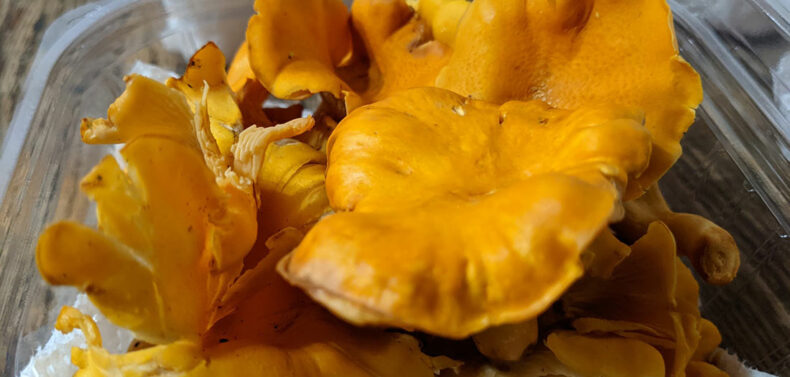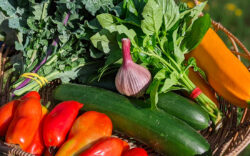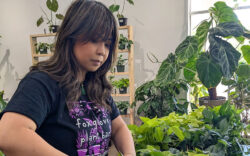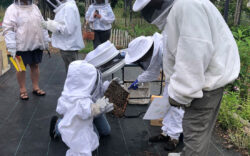If you’ve got the itch to add something new to your garden, consider a leaf-strewn, tree-shrouded spot or protected porch corner for growing mushrooms. You can even grow them indoors. Mushrooms aren’t a new addition to gardening, but can get lost in the shuffle of bright, spring annuals, veggie patches and showy perennials.
Sara Skinner, farmer and owner of Classic City Gourmet Mushrooms, started growing mushrooms in shadier garden patches about 15 years ago as a way to maximize the productive space in her yard. The more she learned about mushrooms, the more she grew and experimented. Four years ago, Skinner began selling her cultivated and foraged mushrooms, as well as easy grow kits, in the Athens area.
The grow buckets are a simple way for folks—even those swearing to have a black thumb—to try their hand at mushrooms, she said. “Mushrooms want to grow,” Skinner said. “It’s self-contained. Everything it needs to grow, it’s in the bucket.”
Growers will need to find a shady spot, protected from wind where the bucket can stay relatively humid. Indoors, buckets won’t dry from the wind. No matter the location, you’ll need to keep the pre-mushroom mush moist with spritzes of water around, not on, the open holes. “You’re not watering the mushrooms. It’s almost like you’re watering the bucket,” Skinner said.
There are other ways to keep the humidity up without constantly misting the bucket with a fine spray of water, Skinner said. She’s kept an essential oil diffuser (without oil) next to grow buckets. Other growers construct small tents over their mushrooms to keep humidity high and consistent.
With the correct combination of shade, humidity and temperature, you will soon start seeing “pins”—tiny, thin towers that will turn into a mushroom in about a week, Skinner said. “They grow really fast,” she said. “Once they start to fruit, they double in size every day.”
Mushroom buckets kept outside (especially in early spring) likely will take longer to fruit because of lower temperatures. Most popular fungi varieties prefer temperatures in the range of 60–80 degrees Fahrenheit. Outside growers should consider harvesting the mushrooms a little smaller and sooner than the same bucket grown indoors, Skinner said. “Everything likes to eat mushrooms, not just humans,” she said.
When you’re thinking about fungi, consider what you like to eat. Oyster mushrooms are beautiful and have a seafood-y flavor. Lion’s mane looks like a stalactite coming, very slowly, to life and tastes a little like crab. Shiitakes are sturdy, meaty specimens and easy to cook.
Unfortunately, some of the most prized fungi species don’t fruit in a domesticated setting. I love the apricot-smelling, almost sweet flavor of chanterelles. I’ve never tried a morel, but I hear they live up to the chef hype. Neither chanterelles nor morels grow easily in human-controlled environments.
If you’re stumped on what to grow first, blue oyster mushrooms are some of the easiest for beginners, whether indoors or out, Skinner said. More ambitious gardeners might want to skip a simple bucket and try something more challenging.
Mushroom plugs, available online, look like little dowels. Infused with mycelium, the plugs hold the vegetative starter needed to cultivate the edible mushroom. Growers take recently felled trees, usually hardwoods, then drill holes into a log, drop in the plugs and cap with wax. This is the typical process for creating mushroom logs.
But logs aren’t the only place to consider growing mushrooms, Skinner said. She mixes oyster mushroom inoculant into the straw covering the garden beds where she grows her tomato plants. I think this is a great system. The straw covers the tomato’s roots, cooling the soil and retaining moisture, while the shade from the tomato plant provides a place for the oyster mushrooms to grow.
Maybe you’re sold on growing the mushrooms, but how will you cook your fungal bounty? If you’re interested in just tasting the mushroom, Skinner suggests a simple saute. “I just saute them. A really good saute to cook the water out of them, and then add your herbs and spices as you like,” she said.
For fancier fare, Skinner sells a mushroom cookbook and sports several free recipes on her website, including an uptown-sounding, yet uncomplicated lion’s mane mushroom crab cake. “It is probably the No. 1 most popular recipe I have on my website,” she said.
In addition to the internet, the Marigold Market, the Athens Farmers Market, Daily Groceries Co-op and Prince Market are good places to find mushrooms and mushroom products.
Like what you just read? Support Flagpole by making a donation today. Every dollar you give helps fund our ongoing mission to provide Athens with quality, independent journalism.









